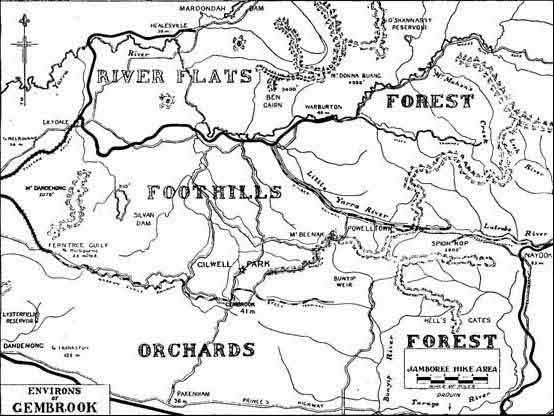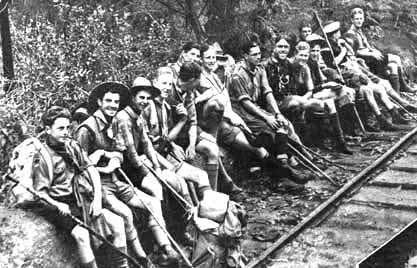
The Jamboree site offered ready access to Frankston beach via Liddesdale Avenue. An area of the foreshore, south of the Fernery (now the Caltex garage), was roped off for the use of Jamboree participants.
Scouts went to and from the beach under the care of a Scouter. A sturdy tower, made of saplings, was manned during swimming hours. The beach committee - distinctive in their white costumes - were responsible for this task.
Hessian dressing sheds were provided on the beach. Regulation costume was obligatory and trunks alone were not permitted.

A large number of Scouts attended the swimming and beach games which took place on the afternoon of Thursday, 3rd January. This event was competitive between sub-camps. The games included canoe racing, pillow fights on the greasy pole, relay races and tugs-of-war on the sand.

The beach carnival (finals of the beach games) scheduled for Saturday, 5th January, was abandoned due to heavy seas and a strong south-westerly gale.
Those Scouts who remained at Frankston after the completion of the formal proceedings were eligible to take part in a variety of excursions. These included - on a daily basis - a yacht trip from Frankston, a tour to Phillip Island and an extensive range of factory visits. In addition, a variety of trips operated in and around Melbourne. Excursions were also available to Dandenong, Ballarat, the Crib Point Naval Base and the State Electricity Commission's works at Yallourn.
At the conclusion of the Frankston activities more than 600 Scouts took part in the hikes program. The older boys started on January 6th from 25 different points; the 14 and 15 year old Scouts were restricted to a two day walk; but all 37 hikes ended at Gilwell Park (Gembrook) on January 10th. Each group had its own itinerary but all were based in the rugged hills and forests around Gembrook.

The hike area (2,000 square miles) included a wide variety of scenery: majestic mountains with panoramic views; glorious fern and beech gullies with water falls and cascades; and tall timbers which offered shaded tracks through the forest.
The hikes were coordinated from a base at Powelltown. The following excerpt was reported by The Age.
"Within a mile of Powelltown there is a small encampment on the fringe of the forest, in the centre of a cluster of tents is a rustic structure lined with maps. It is the control room, where the Rover in charge is kept informed of the movements and needs of each hike party. Under his control are six foot-runners, two speed cars and three motor cycles. At some points in the hike area there is the telephone, and each hike leader must communicate at least once daily with the control room. But telephones in this vast forest and hill country are very rare, hence the foot-runners and the motor and cycle patrols. All these Rovers are expert bushmen, and the runners go out alone for five-hour stretches at nightfall to check up with their four troops of hikers spread over an area of from ten to fifteen miles. They receive the day's report from the hike leaders and collect any letters which the Scouts may have written during the midday spell"

The hike activities had been preceded by lengthy preparations: the training of hike leaders, the improvement of maps, the establishment of routes and campsites, the creation of communication patrols, and the setting up of emergency services.
This Rover led initiative had been assisted by many organisations and citizens, and in particular, the Melbourne Walking Club.
On New Year's Eve, a short-wave broadcast was organised by the Australian Broadcasting Commission. Plans for this event were kept secret. While most Scouts were intent on breakfast, those involved made their way to the display arena.
Soon, a medley of International sounds rent the high empty stands. The program was broadcast to Europe, India, New Zealand and many other countries, as well as to all parts of Australia.
A second broadcast took place on Friday morning, January 4th. It was made from the microphone in the main arena. Members of overseas contingents took part in this event. The broadcast was relayed through all national stations in the Commonwealth by the Australian Broadcasting Commission, and transmitted on the short wave throughout the world.
On most evenings "talkie" pictures were screened at the outdoor theatre. It was located in the hollow between the arena and Overport Road - to the North of the playing field.
The equipment and an operator were provided by the Shell Company. Films were provided by Efftee, British Dominions, British Empire, Universal, Commonwealth Films and Warner Bros.
"The Mayor of Hell" and "Wild Boys of the Road" (Warner Bros.) were amongst those shown.